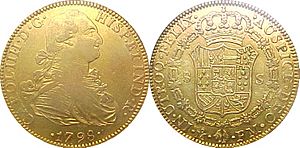Doubloon facts for kids
The doubloon was a famous gold coin from Spain. Its name comes from the Spanish word doblón, which means "double." This is because it was worth twice the value of another Spanish gold coin called the escudo.
A typical doubloon was worth about $4 in Spanish dollars or 32 reales (another type of Spanish coin). It weighed around 6.77 grams (about 0.24 ounces) and was made of 22-karat gold.
These valuable coins were made in Spain and in Spanish territories in the Americas. These places included New Spain (which is now Mexico and parts of the USA), Peru, and Nueva Granada (which includes modern-day Colombia, Ecuador, Panama, and Venezuela). Doubloons are often remembered today because they appear in many stories about pirates and hidden treasures.
Contents
History of the Doubloon
Spanish gold coins in the Americas came in different sizes. They were made in values of one-half, one, two, four, and eight escudos. Each escudo was generally worth about two Spanish dollars.
Different Doubloon Values
The two-escudo coin was often called a "doubloon" or "pistole." It was worth about $4. The much larger eight-escudo coin was known as a "quadruple pistole" and was worth about $16.
It could be a bit confusing because people in different places used the names differently. For example, in England, an $8 coin was sometimes called a doubloon. But in American colonies, the $16 coin was called a doubloon. To make it clearer, people started calling the $4 coin the "common doubloon." The $8 coin was called the "doubloon of four escudos," and the $16 coin was the "doubloon of eight escudos."
Doubloons in Other Places
After the War of 1812, doubloons of eight escudos became very popular in Nova Scotia. They were valued at £4 there and were widely used.
In Spain, doubloons were worth $4 (or 80 reales) until the mid-1800s. In 1859, Isabella II of Spain, the Queen of Spain, changed the money system. She introduced a new, heavier doubloon. This new coin was worth $5 (or 100 reales) and weighed about 8.38 grams. The last Spanish doubloons, showing their value as 80 reales, were made in 1849. After gaining independence, former Spanish colonies like Mexico, Peru, and Nueva Granada continued to make their own doubloons.
Doubloons Around the World
Doubloons were also minted in Portuguese colonies. There, they were called dobrão, which means the same thing. Today, the currency of São Tomé and Príncipe is called the dobra, which is the only modern money name that still means "doubloon."
The doubloon's design and value inspired many other gold coins in Europe. These included the French Louis d'or, the Italian doppia, the Swiss duplone, and the German pistole and Friedrich d'or.
See also
 In Spanish: Doblón para niños
In Spanish: Doblón para niños
- Spanish dollar, also known as a piece of eight
- Brasher Doubloon
- Moby Dick Coin



